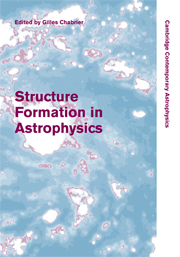Book contents
- Frontmatter
- Contents
- List of contributors
- Preface
- Part I Physical Processes and Numerical Methods Common to Structure Formations in Astrophysics
- 1 The physics of turbulence
- 2 The numerical simulation of turbulence
- 3 Numerical methods for radiation magnetohydrodynamics in astrophysics
- 4 The role of jets in the formation of planets, stars and galaxies
- 5 Advanced numerical methods in astrophysical fluid dynamics
- Part II Structure and Star Formation in the Primordial Universe
- Part III Contemporary Star and Brown Dwarf Formation
- Part IV Protoplanetary Disks and Planet Formation
- Part V Summary
3 - Numerical methods for radiation magnetohydrodynamics in astrophysics
Published online by Cambridge University Press: 11 August 2009
- Frontmatter
- Contents
- List of contributors
- Preface
- Part I Physical Processes and Numerical Methods Common to Structure Formations in Astrophysics
- 1 The physics of turbulence
- 2 The numerical simulation of turbulence
- 3 Numerical methods for radiation magnetohydrodynamics in astrophysics
- 4 The role of jets in the formation of planets, stars and galaxies
- 5 Advanced numerical methods in astrophysical fluid dynamics
- Part II Structure and Star Formation in the Primordial Universe
- Part III Contemporary Star and Brown Dwarf Formation
- Part IV Protoplanetary Disks and Planet Formation
- Part V Summary
Summary
Abstract
We describe numerical methods for solving the equations of radiation magnetohydrodynamics (MHD) for astrophysical fluid flow. Such methods are essential for the investigation of the time-dependent and multidimensional dynamics of a variety of astrophysical systems, although our particular interest is motivated by problems in star formation. Over the past few years, the authors have been members of two parallel code development efforts, and this review reflects that organization. In particular, we discuss numerical methods for MHD as implemented in the Athena code, and numerical methods for radiation hydrodynamics as implemented in the Orion code. We discuss the challenges introduced by the use of adaptive mesh refinement (AMR) in both codes, as well as the most promising directions for future developments.
Introduction
The dynamics of astrophysical systems described by the equations of radiation magnetohydrodynamics (MHD) span a tremendous range of scales and parameter regimes, from the interiors of stars (Kippenhahn & Weigert 1994), to accretion disks around compact objects (Turner et al. 2003), to dusty accretion flows around massive protostars (Krumholz et al. 2005, 2007a), to galactic-scale flows onto AGN (Thompson et al. 2005). All of these systems have in common that matter, radiation and magnetic fields are strongly interacting and that the energy and momentum carried by the radiation field is significant in comparison to that carried by the gas. Thus, an accurate treatment of the problem must include analysis of both the matter and the radiation, as well as the magnetic fields, and their mutual interaction.
- Type
- Chapter
- Information
- Structure Formation in Astrophysics , pp. 37 - 83Publisher: Cambridge University PressPrint publication year: 2009



